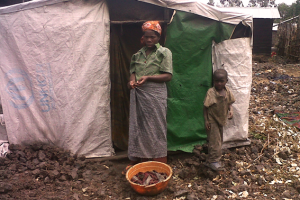John is a 27-year-old, single man whose dream is simply to work so that he can provide for a family. Something, he feels, he can only do with good education under his belt. After he lost his parents, when John was only ten years old, his older brother took care of him and taught him how to work. John finished his secondary schooling, but hasn't been able to afford a tertiary education.
For John, from Goma in the war-torn eastern region of the Democratic Republic of the Congo (DRC), life is very difficult. The entire North Kivu province is marked with hardship and suffering. Life is about surviving another day.
It wasn't always like this. Locals say tourists visited the region, famous as home to the Great Lakes, as recent as 2002. Today - though endowed with vast reserves of gold, copper, cobalt and diamonds - volcano eruptions and increasingly violent rebel attacks have effectively strangled the area.
The eight-year, bloody war has been over for seven years, but the fighting continues. Despite this, the government which is celebrating its 50th year of independence, has closed most of the refugee camps scattered across the eastern provinces of the DRC leaving millions of people homeless. Zambia – impoverished and without much to offer Congolese refugees – has, too, closed two of its camps.
 A young family fighting for survivalLeft with little choice, refugees are returning to their burned-down, vandalized towns often without family members. Stunned, groups of people - unrelated other than sharing the same adversity - congregate to from huddles of make-do communities.
A young family fighting for survivalLeft with little choice, refugees are returning to their burned-down, vandalized towns often without family members. Stunned, groups of people - unrelated other than sharing the same adversity - congregate to from huddles of make-do communities.
Last month Hands at Work founder, George Snyman, visited eastern DRC. George's journey started in Rwanda, the Land of a Thousand Hills, with a hair-raising taxi ride with, closely, the most venturesome driver he has met as of yet! Goma neighbours the Rwandan city of Gisenyi, thus it was heavily affected by the Rwandan Genocide of 1994. This, in turn, fueled the First and Second Congo wars.
En route to the border with the DRC, George noticed that many new buildings were being constructed and schools' signage proclaimed "Hard work and discipline bring success". But, as he got closer to Goma, the scenery and atmosphere transformed into a desperate and tense picture. Scattered refugee camps and orphanages were a reminder of the recent past.
The region is covered in volcanic rock and ash. Everything is grey. And dusty. And dirty. Eight years after the last volcanic outburst, it seems there isn't an inch of ground that isn't covered in rock. Razor-sharp, hard rocks that would cut your feet if you didn't own shoes.
 A typical street sceneWhile Goma is infested with international organisations offering help, the surrounding villages, and especially those beyond the hard-to-reach hills, are left to fend for themselves.
A typical street sceneWhile Goma is infested with international organisations offering help, the surrounding villages, and especially those beyond the hard-to-reach hills, are left to fend for themselves.
Pivotal to the Hands at Work vision, is the commitment to find the villages where no-one else is working. Reaching the poorest for the poor, Hands at Work helps to mobilise and equip local churches to care for the most vulnerable amongst them. Most often they are the women and the children.
Buhimba Village
George's first stop outside Goma, was at Buhimba village. With a population of 6000, many people have settled here after the war. There is very little relief or development activity to be seen in Buhimba and no government services. The village is burdened by a large number of orphans, yet there is virtually no response from the four local, largely unconnected churches.
 Pastor Tshombo (centre) and his congregationGeorge and his host, Aime, pulled up in front of a church led by, they would later learn, Pastor Tshombo. It is a community of people without any shared past. Consisting of refugees that had nowhere else to go, it is a group of people thrown together by circumstance.
Pastor Tshombo (centre) and his congregationGeorge and his host, Aime, pulled up in front of a church led by, they would later learn, Pastor Tshombo. It is a community of people without any shared past. Consisting of refugees that had nowhere else to go, it is a group of people thrown together by circumstance.
People struggle to survive. Women do menial and strenuous tasks such as carrying someone else's goods on their heads for a small fee. Rape has become a frighteningly large problem in the village.
George spent some time with Pastor Tshombo and his church encouraging and challenging them that the children, dirty and vulnerable, were theirs to take care of. Pastor Tshombo, touched by George's message, offered to take him to other villages, which are more remote, the following day.
Nyamasasa Village
Nyamasasa is a rough, 3-hour drive from Goma and has been ravaged, pilfered and raped, quite literally, by the war. Hungry orphans, the sick and widows working others' fields reminds one of Biblical strife.
 There is no external aid to be seen here. The village is extremely isolated and transport is dangerous, expensive and irregular. To top it all, rainfall can cause roads to be impassable.
There is no external aid to be seen here. The village is extremely isolated and transport is dangerous, expensive and irregular. To top it all, rainfall can cause roads to be impassable.
Hunger seems to be one of the biggest challenges. Neema, a widow whom George met, said that life and harvests were good before the war struck. Since the war, agricultural land has been hard to come by and harvests have rendered poorly. Daily, women working in the fields continue to be raped. George reflects that the hopelessness and desperation was tangible. Not woman, nor child had even a hint of a smile.
Munigi, Rurimba and Lumonga Villages
Over the next two days, George visited the Munigi, Rurimba and Lumonga villages and saw a, by now, familiar picture unfolding before him: Churches present, but not working together; a few operational schools, but with low attendance rates; lack of government services; hard, menial labour - tending to others' fields and homes - for minimal income; children and women carrying the brunt of the suffering; clinics without drugs and other resources; diseases such as cholera and malaria hindering the villages' survival even more.
Yet, there is hope when the right people are found. Pastor Boniface, from Munigi village, believes that churches should and can work together. Pastor Boniface oversees a school with roughly 350 learners, 240 of whom are orphans and vulnerable children. Church care workers visit the vulnerable children at their homes, but with limited resources, they can't do very much more than console them.
George met with a group of widows in their burned-down church. They discussed what had happened and the challenges they will face moving forward. George was deeply moved by their stories. One woman, with fear in her eyes, looked up at the surrounding mountains and said softly, "We know they will come back." What would it be like if they knew that Hands at Work will come back?
They will build houses and dwell in them; they will plant vineyards and eat their fruit. No longer will they build houses and others live in them, or plant and others eat. For as the days of a tree, so will be the days of my people; my chosen ones will long enjoy the works of their hands. They will not toil in vain or bear children doomed to misfortune... Isaiah 65: 22-23
Also have a look at Amy Ernst's, an American volunteer in the DRC, guest blog post for the NY Times.
